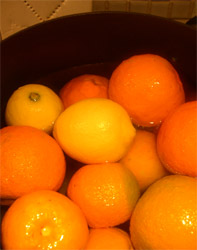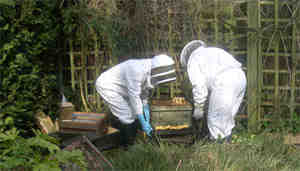Perfect Seville orange marmalade recipe
Posted by Fiona Nevile in Jam Jelly and Preserves | 265 comments As the topping for the best slice of toast of the day, good marmalade is a joy. We like it dark, chunky, hand cut and never in moderation.
As the topping for the best slice of toast of the day, good marmalade is a joy. We like it dark, chunky, hand cut and never in moderation.
Marmalade was the first preserve that we made. We were so proud of it that we could hardly bear to move it from the worktop to the larder, let alone eat it. Eventually we opened the first jar and lavished it on slice after slice of hot buttered toast.
We immediately christened it Intellectual Marmalade as so much ground work, research and care had gone into its manufacture. Visitors who spotted the label were wary of it at breakfast. Would it somehow have an effect on the brain? When they saw us slopping it onto our toast they happily did the same. No one ever mentioned the name.
We like dark old fashioned marmalade. We couldn’t find a recipe for this so we based our recipe on the classic Seville Orange Marmalade in Delia’s Complete Illustrated Cookery Course. We ignored the rolling boil stage and then let it simmer slowly for hours to achieve the dark colour and depth of taste. We tested it for set every twenty minutes. It nearly killed me (I was up for most of the night). Simmering for hours was a key tip from my mother whose marmalade is excellent (I suspect that her inspiration is Mrs Beeton, with knobs on). She wasn’t forthcoming when we dared to ask for the recipe. Update: my mother uses a Pru Leith recipe and adds a couple of tablespoonfuls of molasses to get the dark colour. We recommend the Delia recipe – but simmered very gently for a good six hours to achieve the dark colour and depth of taste naturally. However, I would recommend tasting it every hour or so. When you get the flavour that suits your palate bring the marmalade to a rolling boil immediately and test every 15 minutes for set.
Marmalade can be a bit of a palaver. It starts with hunting down and bagging the fruit. Despite many forays I couldn’t find any Seville oranges this year. Just as I was about to give up I saw them twinkling out in the Cambridge market on Monday. Investing my small change in three kilos of the fruit, I staggered back to the car park with just enough cash to release Jalopy from the gloomy depths.
Having made no notes on the timings of our Intellectual Marmalade recipe, I couldn’t face another day/night of babysitting the bubbling vats. I was determined to find the best old fashioned marmalade recipe, with proper timings. A couple of days ago I discovered a Dark Chunky Marmalade recipe on Delia Online. It’s made in two steps, so it’s great if you are working full time as you can spread the process over two evenings (I would recommend a spreading the task over a weekend unless your evening starts at 15.00 hours). Seville oranges will survive happily in the fridge for at least a week. They keep for months in the freezer and, if you have the room, you can stash them and make fresh marmalade throughout the year.
We have finally made Delia’s Dark Chunky Marmalade. We combined her recipe with our method and simmered ours for a good six hours before setting point was reached. It looks divine and tastes even better than my mum’s. I’m amazed that Paddington Bear hasn’t dropped by.
N.B. If you try this recipe, the poaching liquid is used in the final marmalade. The recipe isn’t very clear on this point and I found the answer in the DeliaOnline forum (press the Community button on her site to access this great resource). Also you need a very large pot! To stop all the peel rising to the top of the jars let the marmalade cool a little before bottling in sterlised jars.
Update January 14th 2011
We now have several new recipes for Seville orange marmalade to suit every taste:
A super three fruit marmalade. A best seller on our gateside stand.
Easy Seville orange marmalade. This fine shredded marmalade is a classic and gets the thumbs up from my mum and is really easy to make!
Seville orange and quince marmalade. Lots of deep flavours in this orange and quince mix.
Leave a reply






The first lot of marmalade I ever made took an age to set. It must have been simmering for at least 6 hours. I then had a brain wave and decided to add the juice of half a lemon (lemon is naturally high in pectin) and hey presto, it almost immediately started setting.
I have just finished the second batch of seville orange marmalade for this year. This time I simmered the peel,juice and bag then left it sitting overnight before boiling it up the next day. The peel is lovely and soft and the flavour is very bitter. I wish I had done the same with the cumquat marmalade that I made earlier in the year. It is subtle and fragrant but the peel is a little tough.
Hello Jane
Thank you so much for your contribution. Can’t wait to try this in January.
Lovely to read a selection of ppost, but YOU ARE ALL WORKING FAR TOO HARD! Katie Stewart, in her 1970s Times Calendar Cook book set me right, and I have since adapted the recipe to suit microwave marmalade production. Never fails. However, a word to the wise, microwave marmalade is only really suitable for small batch production. If, like me you like to vary the cut and flavour, you will welcome this aspect – and avoid having a steam-filled kitchen, which I found to be the case with large batch stove production. And as I am sure nearly all of you will agree that the hardest job (apart from the time dedicated to marmalade making) is the cutting up of the peel, you will be grateful for the effort saved. Cooked peel is so much easier to cut! Herewith the instructions for my method.
1. Clean your fruit, remove the disc select for equal size. Next, boil until soft in your microwave, or on the stove. Save the water, as it is full of pectin.
2. When the fruit has cooled, cut in half, scoop out the pith and pips (and you will find your peel is gratifyingly soft and clean of all pith) and set aside.
3. Chop the peel to required thicknes.
Now add your sugar, and the reserved water.
Follow your usual stove method or microwave recipe. Job done!
Greetings from sunny South Africa! I clicked on this site by accident and am fascinated by all the chit-chat about marmalade. I am an 82 year old great-grandma and have been making marmalade for about 20 years. In fact I am waiting for the first sevilles to appear in the fruit shop in a few wees time. Last year I made 100 bottles and sold them for church funds – my family has christened me the “Marmalade Queen”!!
My recipe is a bit simpler than the ones on your site but I prefer a lighter coloured marmalade than you all seem to make. I slice the whole orange finely, discarding the pips, and then soak the fruit overnight adding 2 cups water to every 1 cup pulp. The next day I slowly boil the mixture for 1-2hours to soften the peel. After that I add 1 cup sugar (we only get cane sugar in SA) to every cup pulp and then boil fairly rapidly until it jells – testing after the first half hour until it reaches 104deg on my sugar thermometer. I find the saucer method of testing very useful. I have a lemon tree in my garden so recently I made a batch using 6 lemons, 2 limes, i orange and 1 grapefruit and it also turned out very well. but maybe those who like a dark marmalade may find my recipe too wishy-washy!
Hello Everyone
l am stunned at reading all about marmalade making here !!
l think that what l am making must be orange or lemon jam because that’s how l make my marmy. l do not use the pips either. As a matter of fact l came by this thread whilst looking for info on why we need to use pips in marmalade.
But my ‘marmalade’ is lovely – especially the mandarine one l made a couple of years ago. My marmy comes out thick and very flavoursome with lots of peel and always a good colour.
l simply slice the fruit very thinly and chop it up a bit and simmer it for about an hour in the water to thoroughly soften it..then add the sugar and disolve it gently…then bring it to the rolling boil till it is ready. lt goes straight into the freshly scalded jars and covered. l put a teaspoonful of vodka on the top to stop mould forming. Exactly the same way as l make my jams and friends and family are always wanting more.
l bet you’re all thinking OMG that’s NOT real marmalade etc… but it is easy and works for me !!
Janet in Kent
Rachel, congratulations on your first batch!
Sevilles should be in the shops from early January, I think I picked up my first batch around mid-Jan this year. However, a local grocer was selling-off the end of his supply last weekend (1st March) at only 50p/kg! I made my last batch yesterday. If you can find any last minute bargain Sevilles at the moment you could always freeze them for later in the year.
As for bitterness, try reducing the sugar by about 100 gm per 1 kg of oranges used and it should be fine.
Hope that helps!
Just letting everyone know that I managed to make my first batch of marmalade with great success, thanks to many helpful hints from here. Its absolutely fantastic and already much enjoyed on toast. So, just wondered whether its possible to reduce the sugar to make a slightly more bitter marmalade – I used Delia’s recipe? Would it still work? Also does anyone know when is the right time to start looking for Seville oranges in the shops? I always seem to miss them and want to make sure I actually get some next year. Thanks again, a big thanks to everyone!!
Hello there, I love making marmalade especially Seville. Do you know, (as I normally use my aluminium preserving pan) whether it is possible to use a fancy copper one instead ? Not too harmful or nasty flavoured ? It doesn’t have a lid, so maybe I should stick to my very old and trusted one.
Any advice would be welcome ! Thanks.
Thank you everyone for all your good advice. Got the muslin from Lakeland yesterday and am using my old large pan that my MIL gave me when we got married. The marmalade is currently simmering away – smells absolutely divine – and I am very excited to see how it all turns out! You marmalade making folk are all such nice people willing to share your experience. I feel like a real greenie this being my first time and everything….so far so good, fingers crossed (peers anxiously into pan remembering all the tales of things going wrong)